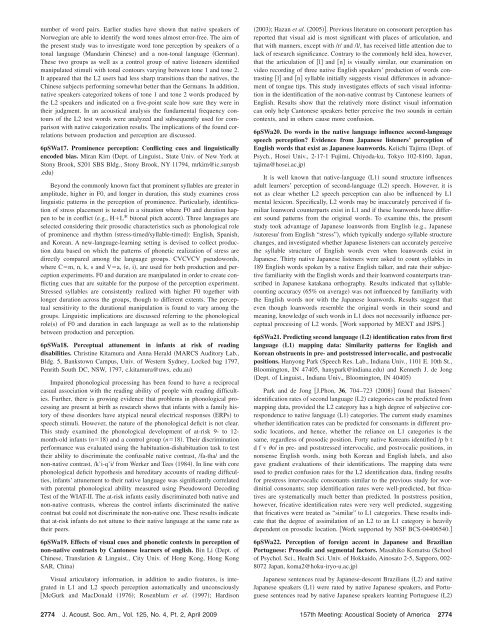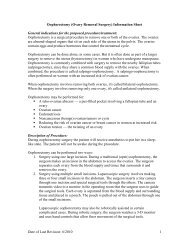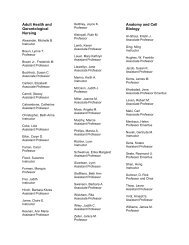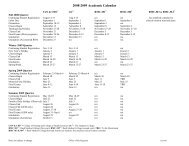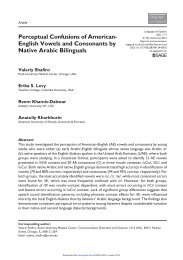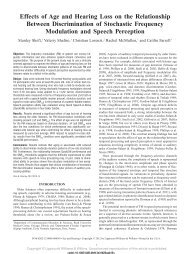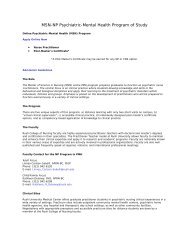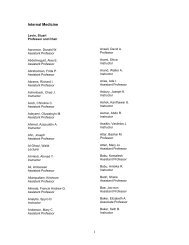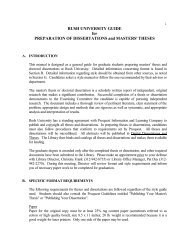Perceptual confusions of American English vowels ... - Rush University
Perceptual confusions of American English vowels ... - Rush University
Perceptual confusions of American English vowels ... - Rush University
You also want an ePaper? Increase the reach of your titles
YUMPU automatically turns print PDFs into web optimized ePapers that Google loves.
number <strong>of</strong> word pairs. Earlier studies have shown that native speakers <strong>of</strong><br />
Norwegian are able to identify the word tones almost error-free. The aim <strong>of</strong><br />
the present study was to investigate word tone perception by speakers <strong>of</strong> a<br />
tonal language Mandarin Chinese and a non-tonal language German.<br />
These two groups as well as a control group <strong>of</strong> native listeners identified<br />
manipulated stimuli with tonal contours varying between tone 1 and tone 2.<br />
It appeared that the L2 users had less sharp transitions than the natives, the<br />
Chinese subjects performing somewhat better than the Germans. In addition,<br />
native speakers categorized tokens <strong>of</strong> tone 1 and tone 2 words produced by<br />
the L2 speakers and indicated on a five-point scale how sure they were in<br />
their judgment. In an acoustical analysis the fundamental frequency contours<br />
<strong>of</strong> the L2 test words were analyzed and subsequently used for comparison<br />
with native categorization results. The implications <strong>of</strong> the found correlations<br />
between production and perception are discussed.<br />
6pSWa17. Prominence perception: Conflicting cues and linguistically<br />
encoded bias. Miran Kim Dept. <strong>of</strong> Linguist., State Univ. <strong>of</strong> New York at<br />
Stony Brook, S201 SBS Bldg., Stony Brook, NY 11794, mrkim@ic.sunysb<br />
.edu<br />
Beyond the commonly known fact that prominent syllables are greater in<br />
amplitude, higher in F0, and longer in duration, this study examines cross<br />
linguistic patterns in the perception <strong>of</strong> prominence. Particularly, identification<br />
<strong>of</strong> stress placement is tested in a situation where F0 and duration happen<br />
to be in conflict e.g., HL* bitonal pitch accent. Three languages are<br />
selected considering their prosodic characteristics such as phonological role<br />
<strong>of</strong> prominence and rhythm stress-timed/syllable-timed: <strong>English</strong>, Spanish,<br />
and Korean. A new-language-learning setting is devised to collect production<br />
data based on which the patterns <strong>of</strong> phonetic realization <strong>of</strong> stress are<br />
directly compared among the language groups. CVCVCV pseudowords,<br />
where Cm, n, k, s and Va, e, i, are used for both production and perception<br />
experiments. F0 and duration are manipulated in order to create conflicting<br />
cues that are suitable for the purpose <strong>of</strong> the perception experiment.<br />
Stressed syllables are consistently realized with higher F0 together with<br />
longer duration across the groups, though to different extents. The perceptual<br />
sensitivity to the durational manipulation is found to vary among the<br />
groups. Linguistic implications are discussed referring to the phonological<br />
roles <strong>of</strong> F0 and duration in each language as well as to the relationship<br />
between production and perception.<br />
6pSWa18. <strong>Perceptual</strong> attunement in infants at risk <strong>of</strong> reading<br />
disabilities. Christine Kitamura and Anna Herald MARCS Auditory Lab.,<br />
Bldg. 5, Bankstown Campus, Univ. <strong>of</strong> Western Sydney, Locked bag 1797,<br />
Penrith South DC, NSW, 1797, c.kitamura@uws, edu.au<br />
Impaired phonological processing has been found to have a reciprocal<br />
casual association with the reading ability <strong>of</strong> people with reading difficulties.<br />
Further, there is growing evidence that problems in phonological processing<br />
are present at birth as research shows that infants with a family history<br />
<strong>of</strong> these disorders have atypical neural electrical responses ERPs to<br />
speech stimuli. However, the nature <strong>of</strong> the phonological deficit is not clear.<br />
This study examined the phonological development <strong>of</strong> at-risk 9- to 12-<br />
month-old infants n18 and a control group n18. Their discrimination<br />
performance was evaluated using the habituation-dishabituation task to test<br />
their ability to discriminate the confusable native contrast, /fa-tha/ and the<br />
non-native contrast, /k’i-q’i/ from Werker and Tees 1984. In line with core<br />
phonological deficit hypothesis and hereditary accounts <strong>of</strong> reading difficulties,<br />
infants’ attunement to their native language was significantly correlated<br />
with parental phonological ability measured using Pseudoword Decoding<br />
Test <strong>of</strong> the WIAT-II. The at-risk infants easily discriminated both native and<br />
non-native contrasts, whereas the control infants discriminated the native<br />
contrast but could not discriminate the non-native one. These results indicate<br />
that at-risk infants do not attune to their native language at the same rate as<br />
their peers.<br />
6pSWa19. Effects <strong>of</strong> visual cues and phonetic contexts in perception <strong>of</strong><br />
non-native contrasts by Cantonese learners <strong>of</strong> english. Bin Li Dept. <strong>of</strong><br />
Chinese, Translation & Linguist., City Univ. <strong>of</strong> Hong Kong, Hong Kong<br />
SAR, China<br />
Visual articulatory information, in addition to audio features, is integrated<br />
in L1 and L2 speech perception automatically and unconsciously<br />
McGurk and MacDonald 1976; Rosenblum et al. 1997; Hardison<br />
2003; Hazan et al. 2005. Previous literature on consonant perception has<br />
reported that visual aid is most significant with places <strong>of</strong> articulation, and<br />
that with manners, except with /r/ and /l/, has received little attention due to<br />
lack <strong>of</strong> research significance. Contrary to the commonly held idea, however,<br />
that the articulation <strong>of</strong> l and n is visually similar, our examination on<br />
video recording <strong>of</strong> three native <strong>English</strong> speakers’ production <strong>of</strong> words contrasting<br />
l and n syllable initially suggests visual differences in advancement<br />
<strong>of</strong> tongue tips. This study investigates effects <strong>of</strong> such visual information<br />
in the identification <strong>of</strong> the non-native contrast by Cantonese learners <strong>of</strong><br />
<strong>English</strong>. Results show that the relatively more distinct visual information<br />
can only help Cantonese speakers better perceive the two sounds in certain<br />
contexts, and in others cause more confusion.<br />
6pSWa20. Do words in the native language influence second-language<br />
speech perception Evidence from Japanese listeners’ perception <strong>of</strong><br />
<strong>English</strong> words that exist as Japanese loanwords. Keiichi Tajima Dept. <strong>of</strong><br />
Psych., Hosei Univ., 2-17-1 Fujimi, Chiyoda-ku, Tokyo 102-8160, Japan,<br />
tajima@hosei.ac.jp<br />
It is well known that native-language L1 sound structure influences<br />
adult learners’ perception <strong>of</strong> second-language L2 speech. However, it is<br />
not as clear whether L2 speech perception can also be influenced by L1<br />
mental lexicon. Specifically, L2 words may be inaccurately perceived if familiar<br />
loanword counterparts exist in L1 and if these loanwords have different<br />
sound patterns from the original words. To examine this, the present<br />
study took advantage <strong>of</strong> Japanese loanwords from <strong>English</strong> e.g., Japanese<br />
/sutoresu/ from <strong>English</strong> “stress”, which typically undergo syllable structure<br />
changes, and investigated whether Japanese listeners can accurately perceive<br />
the syllable structure <strong>of</strong> <strong>English</strong> words even when loanwords exist in<br />
Japanese. Thirty native Japanese listeners were asked to count syllables in<br />
189 <strong>English</strong> words spoken by a native <strong>English</strong> talker, and rate their subjective<br />
familiarity with the <strong>English</strong> words and their loanword counterparts transcribed<br />
in Japanese katakana orthography. Results indicated that syllablecounting<br />
accuracy 65% on average was not influenced by familiarity with<br />
the <strong>English</strong> words nor with the Japanese loanwords. Results suggest that<br />
even though loanwords resemble the original words in their sound and<br />
meaning, knowledge <strong>of</strong> such words in L1 does not necessarily influence perceptual<br />
processing <strong>of</strong> L2 words. Work supported by MEXT and JSPS.<br />
6pSWa21. Predicting second language (L2) identification rates from first<br />
language (L1) mapping data: Similarity patterns for <strong>English</strong> and<br />
Korean obstruents in pre- and poststressed intervocalic, and postvocalic<br />
positions. Hanyong Park Speech Res. Lab., Indiana Univ., 1101 E. 10th St.,<br />
Bloomington, IN 47405, hanypark@indiana.edu and Kenneth J. de Jong<br />
Dept. <strong>of</strong> Linguist., Indiana Univ., Bloomington, IN 40405<br />
Park and de Jong J.Phon, 36, 704–723 2008 found that listeners’<br />
identification rates <strong>of</strong> second language L2 categories can be predicted from<br />
mapping data, provided the L2 category has a high degree <strong>of</strong> subjective correspondence<br />
to native language L1 categories. The current study examines<br />
whether identification rates can be predicted for consonants in different prosodic<br />
locations, and hence, whether the reliance on L1 categories is the<br />
same, regardless <strong>of</strong> prosodic position. Forty native Koreans identified /p b t<br />
dfvo/ in pre- and poststressed intervocalic, and postvocalic positions, in<br />
nonsense <strong>English</strong> words, using both Korean and <strong>English</strong> labels, and also<br />
gave gradient evaluations <strong>of</strong> their identifications. The mapping data were<br />
used to predict confusion rates for the L2 identification data, finding results<br />
for prestress intervocalic consonants similar to the previous study for wordinitial<br />
consonants; stop identification rates were well-predicted, but fricatives<br />
are systematically much better than predicted. In poststress position,<br />
however, fricative identification rates were very well predicted, suggesting<br />
that fricatives were treated as “similar” to L1 categories. These results indicate<br />
that the degree <strong>of</strong> assimilation <strong>of</strong> an L2 to an L1 category is heavily<br />
dependent on prosodic location. Work supported by NSF BCS-04406540.<br />
6pSWa22. Perception <strong>of</strong> foreign accent in Japanese and Brazilian<br />
Portuguese: Prosodic and segmental factors. Masahiko Komatsu School<br />
<strong>of</strong> Psychol. Sci., Health Sci. Univ. <strong>of</strong> Hokkaido, Ainosato 2-5, Sapporo, 002-<br />
8072 Japan, koma2@hoku-iryo-u.ac.jp<br />
Japanese sentences read by Japanese-descent Brazilians L2 and native<br />
Japanese speakers L1 were rated by native Japanese speakers, and Portuguese<br />
sentences read by native Japanese speakers learning Portuguese L2<br />
2774 J. Acoust. Soc. Am., Vol. 125, No. 4, Pt. 2, April 2009 157th Meeting: Acoustical Society <strong>of</strong> America 2774


